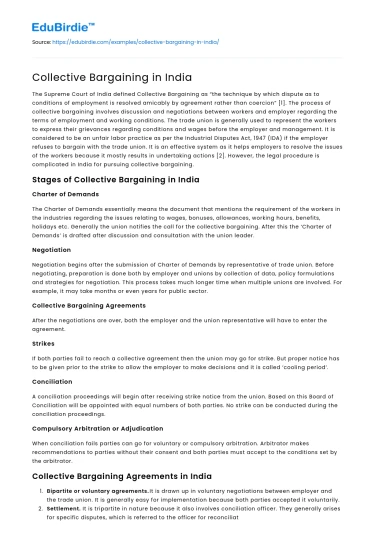The Supreme Court of India defined Collective Bargaining as “the technique by which dispute as to conditions of employment is resolved amicably by agreement rather than coercion” [1]. The process of collective bargaining involves discussion and negotiations between workers and employer regarding the terms of employment and working conditions. The trade union is generally used to represent the workers to express their grievances regarding conditions and wages before the employer and management. It is considered to be an unfair labor practice as per the Industrial Disputes Act, 1947 (IDA) if the employer refuses to bargain with the trade union. It is an effective system as it helps employers to resolve the issues of the workers because it mostly results in undertaking actions [2]. However, the legal procedure is complicated in India for pursuing collective bargaining.
Stages of Collective Bargaining in India
Charter of Demands
The Charter of Demands essentially means the document that mentions the requirement of the workers in the industries regarding the issues relating to wages, bonuses, allowances, working hours, benefits, holidays etc. Generally the union notifies the call for the collective bargaining. After this the ‘Charter of Demands’ is drafted after discussion and consultation with the union leader.
Save your time!
We can take care of your essay
- Proper editing and formatting
- Free revision, title page, and bibliography
- Flexible prices and money-back guarantee
Negotiation
Negotiation begins after the submission of Charter of Demands by representative of trade union. Before negotiating, preparation is done both by employer and unions by collection of data, policy formulations and strategies for negotiation. This process takes much longer time when multiple unions are involved. For example, it may take months or even years for public sector.
Collective Bargaining Agreements
After the negotiations are over, both the employer and the union representative will have to enter the agreement.
Strikes
If both parties fail to reach a collective agreement then the union may go for strike. But proper notice has to be given prior to the strike to allow the employer to make decisions and it is called ‘cooling period’.
Conciliation
A conciliation proceedings will begin after receiving strike notice from the union. Based on this Board of Conciliation will be appointed with equal numbers of both parties. No strike can be conducted during the conciliation proceedings.
Compulsory Arbitration or Adjudication
When conciliation fails parties can go for voluntary or compulsory arbitration. Arbitrator makes recommendations to parties without their consent and both parties must accept to the conditions set by the arbitrator.
Collective Bargaining Agreements in India
- Bipartite or voluntary agreements. It is drawn up in voluntary negotiations between employer and the trade union. It is generally easy for implementation because both parties accepted it voluntarily.
- Settlement. It is tripartite in nature because it also involves conciliation officer. They generally arises for specific disputes, which is referred to the officer for reconciliation.
- Consent awards. When an agreement is reached while the dispute is pending before a compulsory adjudicatory authority and incorporated into the authority’s award it is called as consent awards. Even though the agreement is reached voluntarily it becomes part of binding award pronounced by the authority constituted for the purpose.
Contents of Collective Bargaining Agreements
After the agreement is reached a memorandum of settlements is drafted which enumerate the various clauses that tells the relationship between trade union and employer. Typical clauses in the memorandum of settlements are as follows:
- The duration of the memorandum of settlement that has been agreed by the parties.
- The terms regarding settlement with respect to wages and other payment related activities has to be mentioned. Also arrears with respect to work hours, concession has to be included.
- In case of strikes and lockouts of trade union, the conditions for the same has to be mentioned.
- The obligation raised by the trade union.
- The obligations of the employer regarding the terms.
- The penalties regarding the breach of agreements of employer and trade union.
- The dispute resolution method has to be mentioned the clauses.
Levels of Collective Bargaining in India
National Level Industrial Bargaining
This is centralized bargaining unit. Common in core industries such as banks, coal, steel, ports and docks and oil where central government employments are dominant.
Industrial Cum Regional Bargaining
Generally takes place in tripartite form. Common in industries where the private sector dominates such as cotton, jute, textiles, engineering, tea plantation, portsiiand docks.
Enterprise or Plant Level Bargaining
It takes place within the particular industry where problem arises. Bargaining takes place between one or more unions with the employer of management. Takes place only in private industries.
Unit level Bargaining
This is decentralized bargaining system. Generally takes place in MNC’s belonging to IT industry and bargaining generally takes place at individual level.






 Stuck on your essay?
Stuck on your essay?

